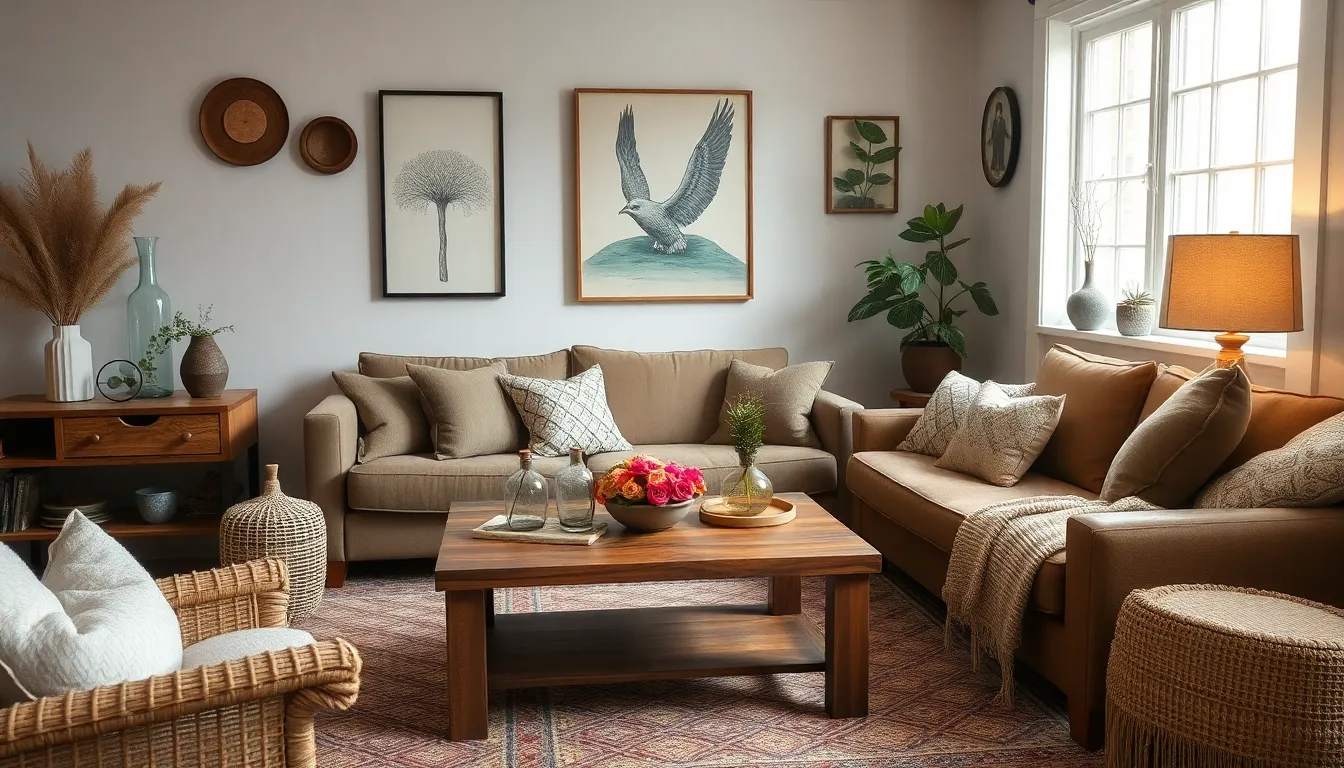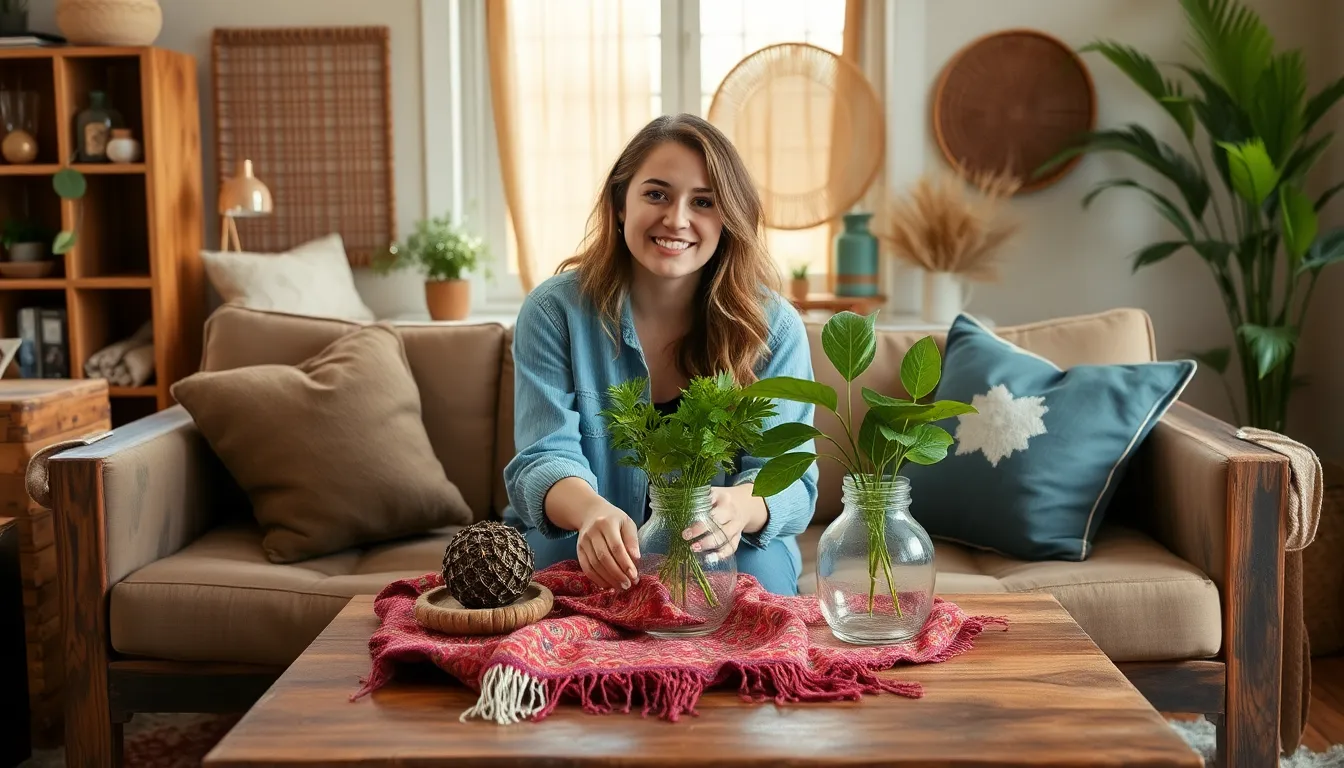Table of Contents
ToggleIn a world where plastic reigns supreme, eco-friendly decorations are the breath of fresh air that every home needs. Imagine transforming your space with vibrant, sustainable pieces that not only look good but also make Mother Nature smile. It’s like giving your living room a hug while keeping the planet in mind—talk about multitasking!
Choosing eco-friendly decor doesn’t mean sacrificing style. From reclaimed wood accents to upcycled textiles, these options are as chic as they are sustainable. Plus, they come with a built-in conversation starter: “Oh, this? Just a little something I picked up while saving the planet.” So, if you’re ready to turn your home into an eco-chic haven, dive into the world of green decorations and let your style shine while keeping the Earth in mind.
Benefits Of Eco-Friendly Decorations
Eco-friendly decorations enhance home design while promoting sustainability. They provide both aesthetic appeal and environmental responsibility.
Environmental Impact
Eco-friendly decorations reduce carbon footprints significantly. Materials like reclaimed wood and bamboo contribute to lower emissions compared to traditional decor. Production processes for sustainable items often require less energy, reducing overall environmental strain. The use of upcycled textiles minimizes waste, promoting a circular economy where usable materials get new life. Opting for local artisans also cuts down transportation emissions, further benefiting the planet. Environmentally friendly choices help preserve natural resources and ecosystems by promoting responsible consumption.
Health Benefits
Health improvements often accompany eco-friendly decor choices. Non-toxic paints and finishes reduce exposure to harmful chemicals. Improved indoor air quality results when using natural materials that emit fewer volatile organic compounds. Eco-friendly decorations frequently feature hypoallergenic options, benefiting individuals with sensitivities. Natural textiles contribute to a more comfortable living environment while reducing the risk of respiratory issues. Additionally, incorporating plants into home decor enhances well-being through better air purification and increased humidity control.
Types Of Eco-Friendly Decorations

Eco-friendly decorations come in various forms, enhancing aesthetics while promoting sustainability. These options not only beautify spaces but also support environmental health.
Natural Materials
Using natural materials adds warmth and texture to a home. Wood, stone, and bamboo serve as excellent choices. Reclaimed wood, recycled from old buildings, features unique character and history. Bamboo represents a fast-growing resource, which makes it an eco-friendly alternative. Natural fibers like jute or seagrass also provide sustainable decor options.
Recycled and Upcycled Items
Recycled and upcycled items transform waste into functional art. Furniture crafted from recycled materials showcases creativity and resourcefulness. Vintage pieces serve as stylish additions, reducing the demand for new production. Upcycled glass bottles can become stunning vases or light fixtures. Many crafty solutions exist to repurpose everyday items, sparking innovation and reducing landfill contributions.
Sustainable Fabrics
Sustainable fabrics offer a variety of eco-friendly decoration choices. Organic cotton, produced without harmful pesticides, ensures safety for both humans and the environment. Linen, made from flax, consumes less water during production and biodegrades easily. Additionally, hemp emerges as a sturdy and renewable fabric option. Incorporating these textiles into curtains, tablecloths, and cushions enhances indoor aesthetics while prioritizing sustainability.
How To Incorporate Eco-Friendly Decorations
Incorporating eco-friendly decorations into a home enhances aesthetics while promoting sustainability. Many options exist that fit diverse styles and preferences.
Home Decor Tips
Choose natural materials like bamboo and reclaimed wood for furniture. Opt for organic textiles, such as cotton or linen, for curtains and cushions. Incorporate plants to improve air quality and add vibrant colors. Embrace handmade items crafted by local artisans, which often feature sustainable practices. Select paint brands with low volatile organic compounds to maintain indoor health. Prioritize second-hand stores and online marketplaces for unique decor pieces, reducing waste while adding character.
Seasonal Decorations
Utilize natural elements for seasonal decor, such as pine cones and dried flowers. Create centerpieces with locally sourced fruits and vegetables for a colorful touch. Use reusable fabric or paper decorations instead of single-use items for holidays. Craft ornaments from recycled materials during festive seasons for a personal touch. Incorporate seasonal wreaths made from native plants to welcome each time of year. Retain a balance between decorating and sustainability for a conscientious approach.
Popular Eco-Friendly Decoration Trends
Eco-friendly decoration trends focus on sustainability and aesthetics. These styles enhance homes while reducing environmental impact.
Minimalism
Minimalism emphasizes simplicity and functionality. Less clutter creates a calming environment, which promotes mental well-being. Sustainable materials like bamboo or reclaimed wood often feature in minimalist designs. Natural colors create a serene atmosphere. Decorative pieces remain functional, eliminating excess and encouraging purposeful living. By opting for fewer, high-quality items, homeowners support brands that prioritize sustainability.
Biophilic Design
Biophilic design integrates nature into indoor spaces. This approach improves well-being and enhances air quality. Incorporating plants like spider plants or peace lilies creates a vibrant connection to nature. Natural light plays an essential role, so large windows or strategically placed mirrors maximize sunlight. Using organic materials in furnishings brings outdoor elements inside, fostering a sense of calm. By creating harmonious spaces that echo nature, individuals experience both aesthetic and health benefits.
Embracing eco-friendly decorations not only enhances the beauty of a home but also supports a healthier planet. By choosing sustainable materials and practices, individuals can create spaces that reflect their values while contributing to environmental well-being. The integration of natural elements and upcycled items fosters a unique aesthetic that resonates with modern design trends.
As more people recognize the importance of sustainability, eco-friendly decor will continue to gain popularity. It’s an opportunity to make a positive impact while enjoying a stylish and comfortable living environment. Adopting these practices encourages a lifestyle that prioritizes both personal comfort and the health of the planet.







